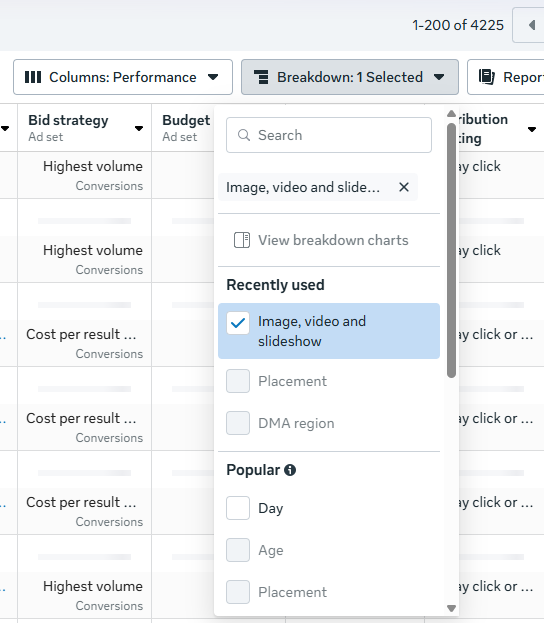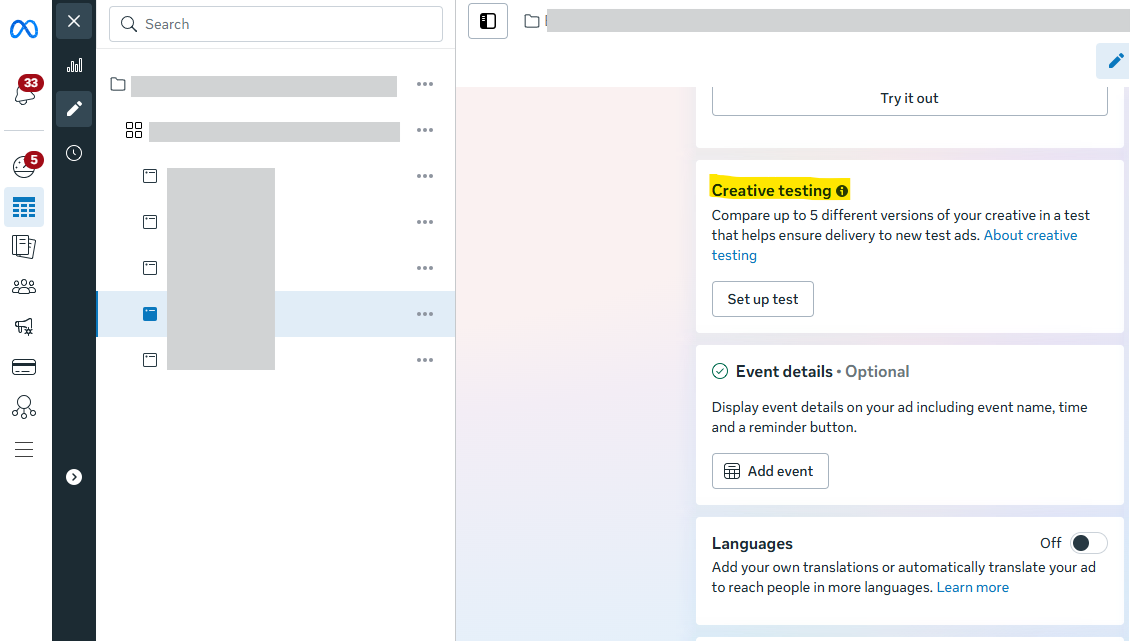When running a Meta Ads campaign, creative should be at the center of your strategy. As targeting options have become more limited in the platform from the super-granular segments available in years past, overthinking targeting layers often raises cost while sacrificing performance.
Meta has also been emphasizing the importance of differentiating creative, warning that similar assets will essentially be seen as the same by their system, and potentially limiting reach as audience fatigue sets in from seeing an image or video over and over.
Assuming you’ve started with a foundation of properly configured event tracking, keeping your audience targeting high-level and focusing on testing diverse creative will generally drive the best results. Given the importance of creative, understanding how you can view the performance of your assets is crucial to informing your Meta advertising strategy.
Breaking It Down
From the main Ads Manager screen, you can use the Breakdown option to segment performance by individual ad creative (images and videos). This can be done at either the ad set or ad level.
 Image from author, October 2025
Image from author, October 2025You can then see metrics such as clicks, link clicks, impressions, cost-per-click (CPC), click-through rate (CTR), reach, frequency, and spend for individual assets. However, you unfortunately cannot see counts for custom conversions or events broken down at this level.
While the lack of conversion data is a miss on Meta’s part, you can still find value in this reporting. If you’re using dynamic creative, you can see which individual assets are being served the most and which are receiving the highest engagement (based on CTR). You can also determine if frequency is running high for particular assets and if fatigue may be setting in.
If you’re running a single image ad without dynamic creative, but using different images for various placements (e.g., square images for feed placements and vertical images for Stories/Reels), you can still see conversion performance separated by breaking down by Placement instead of creative. Here, you can also delineate between different platforms (Facebook vs. Instagram vs. Threads) for individual placement types as well.
Custom Reporting
You can also use the Ads Reporting section to create a custom report that includes individual ad creatives in addition to metrics you’d like to see. When building your report, use a pivot table and check the box for “Ad creative” if you’d like to see data aggregated across campaigns and ad sets that are using the same creative.
 Image from author, October 2025
Image from author, October 2025You’ll then see a thumbnail of the image or video, along with the accompanying copy. This report can be helpful for doing aggregate comparisons of how specific images are performing if you’re reusing them for different ad sets or campaigns. For instance, you may have campaigns segmented by market for budget reasons, but be serving the same assets.
Creative Testing
We’ve looked at how to view creative performance across your Meta campaigns in a couple of different ways, but what if you want to stage a test from the ground up to compare how different creative assets might perform? You can use the standard Experiments feature that has existed for a while in Meta and set up separate ad sets or campaigns with different ads, but let’s hone in on the Creative Testing feature that’s specifically built for this purpose.
To kick off a test, go to the edit view for an existing ad within a campaign and scroll down until you see the “Creative Testing” section. Select the option to “Set up test.”
 Image from author, October 2025
Image from author, October 2025Next, you can define the criteria for your test setup. Start by choosing to create up to five ads. Then, allocate the amount of budget that you’d like to use and define the length of the test (up to 30 days).
 Image from author, October 2025
Image from author, October 2025Finally, select the metric you’ll use to evaluate success. You can choose a more general goal, such as CPC or cost per result, or you can choose a specific conversion (either custom conversion or event) to look at CPA.
Finally, confirm your test, and adjust the new creatives to include the updated assets you’d like to use. You can then view results in the Experiments section, or via the campaign in Ads Manager, as the test begins to run.
According to Meta, using this approach allows you to keep learnings from the test ads within your ad set if you choose to run them moving forward. As the learning phase can be a hindrance to getting new ads off the ground, this tactic can be a benefit in addition to the ease of testing.
Measurement Outside Meta
In addition to what you can see in Meta, use tools such as Google Analytics to see performance from ad clicks to your site. As long as you’ve properly tagged your ad URLs, you can see how specific ones have driven engagement and conversions on your site.
Meta’s attribution (even click attribution) is notorious for taking all the credit it can, but using another platform can allow you to see Meta traffic alongside other sources that may also have influenced conversion. You can then determine how Meta may have influenced the buying journey, as it often may appear earlier in consideration and be followed up by sources such as search.
What Should You Test?
How can you plan creative tests that give you actionable data? As discussed at the beginning of the article, differentiation is key to both avoiding fatigue and providing significant results.
While design capabilities may vary depending on your business’s resources and bandwidth, the availability of a plethora of AI tools and user-friendly design platforms allows for simple creation of multiple assets. Think through what works best for your brand, but some potential suggestions for comparison include:
- Illustrated vector images vs. photography.
- Stock photography vs. your brand’s photography.
- Animation vs. static images.
- Text-heavy assets vs. minimal or no text.
- Informal “phone” videos vs. polished formal videos.
From here, you can evaluate which types of assets tend to best resonate with your audience based on the data you’re able to see both in Meta and in third-party platforms. Also, be careful not to completely write off a particular type of creative because of a past test. Audience preferences can change over time, so it’s worth retesting periodically.
How Can You Apply Your Learnings?
As you evaluate the performance of various assets, you can translate the learnings into practical application in Meta and beyond. For instance, if you find that animated text videos tend to perform well, you can create them for multiple products and test different video backgrounds.
Additionally, take learnings beyond Meta and apply them to other platforms. With the caveat that each platform is unique and what works on one may not be guaranteed to perform elsewhere, images that work on Meta may be worth testing in other channels, such as Google Demand Gen and LinkedIn.
Outside of ad platforms, you can also implement image styles or videos that performed in Meta testing onto your landing pages. For instance, if your Meta audience appears to resonate more with illustrated vector imagery as opposed to photography, test that type of creative in graphics on your site.
Start Evaluating & Start Testing
If you haven’t previously been paying enough attention to the performance of specific creatives in Meta, now is a crucial time to start doing so. Ensure that you’re using different enough variants and avoiding fatigue. Think through some tests you can set up for your clients or your brand, and start creating and launching new graphics.
More Resources:
- Budget Allocation: When To Choose Google Ads Vs. Meta Ads
- Tips For Running Paid Media Campaigns In Highly Regulated Industries
- PPC Trends 2026
Featured Image: Viktoriia_M/Shutterstock


